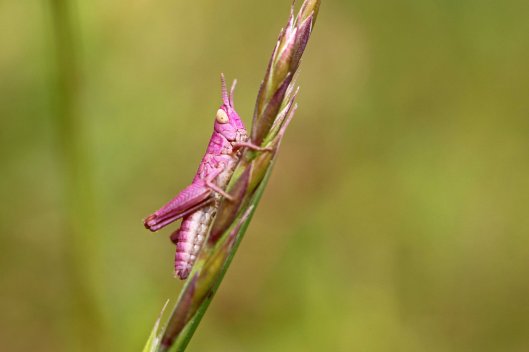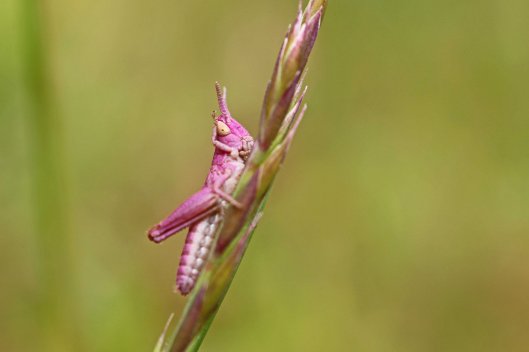Tags
Chorthippus parallelus, genetic mutation, Kenfig National Nature Reserve, Meadow grasshopper, pink grasshopper
If someone had told me before last Saturday that there was such a thing as a pink grasshopper living in Wales, I would’ve laughed and assumed they were having me on … but, as they say, seeing is believing.

This is another of the amazing creatures I encountered at Kenfig National Nature Reserve last weekend. It’s a Meadow grasshopper (Chorthippus parallelus), a common species throughout Europe and in parts of Asia. With its lake and ponds, and its frequently damp dune slacks, Kenfig has the perfect habitat for this grasshopper which prefers moist vegetation rather than a dry environment. Although green is the most common colour, the Meadow grasshopper can also be completely or partially brown, a reddish-purple and, yes, pink. It appears that the pink colour is a result of a genetic mutation during the reproductive cycle, similar to that which causes albinism. And it is definitely a she as, apparently, only the females are affected by this recessive gene.


Whoa! And I love how she picked a color-coordinated plant to hang out on.
LikeLiked by 1 person
She’s a natural model, Debbie. Thank you. 🙂
LikeLike
Pingback: Welsh biodiversity: Kenfig NNNR | earthstar
thats beautiful. Never seen one myself, but now I know they’re out there i’ll keep looking .
LikeLiked by 1 person
It was a very lucky find, Jackie, and she was happy to pose for me. She was a little star! 🙂
LikeLike
Wow! I have never, ever seen a pink grasshopper before. It’s wonderful! But however do they camouflage themselves? Methinks maybe they hide in large pink flowers or wait til sunset and silhouette themselves against a pink sky. 🙂
LikeLiked by 1 person
Predation because of their obvious colour can be an issue, apparently, Val, yet some seem to survive. I like your sunset vision! 🙂
LikeLiked by 1 person
Wow! I’ve seen a few Meadow Grasshoppers but never like that!
LikeLiked by 1 person
She was a little beauty, thanks, Paul. Apparently, not common, though there are localised populations in various places here and in England where the genetic mutation is present.
LikeLike
It’s a very good looking grasshopper. What a colour.
LikeLiked by 1 person
It certainly caught my eye. Thanks! 🙂
LikeLiked by 1 person
Very pretty.
LikeLiked by 1 person
Thanks, Joyce.
LikeLiked by 1 person